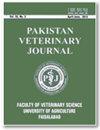求助PDF
{"title":"日粮中添加酵母对日本鹌鹑生长性能、选定血清参数、肠道形态及致病菌减少的影响","authors":"A. A. El-Wahab, R. Mahmoud, Basma H. Marghani, Hossam Gadallah","doi":"10.29261/pakvetj/2019.125","DOIUrl":null,"url":null,"abstract":"Received: Revised: Accepted: Published online: May 08, 2019 November 03, 2019 November 04, 2019 December 26, 2019 The objectives of the current study were to investigate the impact of dietary yeast (Saccharomyces cerevisiae) supplementation on growth performance, some serum parameters, intestinal morphology and pathogens reduction in Japanese quails. In total, 300 d-old Japanese quails were randomly allocated to 5 dietary groups (6 replicates of 10 Japanese quails per pen). At beginning of the experiment (d 14), Japanese quails fed a basal diet without contain any yeast while, the other treatments provided basal diet plus 0.5, 1.5, 2.5 and 3.5% yeast on feed basis. The results showed that dietary supplementation of yeast, particularly at a level of inclusion of 3.5% on feed basis, resulted in highest BW for Japanese quails (P<0.05). Japanese quails fed diets supplemented with yeast reduced (P<0.05) cholesterol and triglycerides concentrations in serum compared to control. Dietary yeast supplementation at 3.5% reduced (P<0.05) interleukin 1 β (IL-1 β), IL-6 and TNF-α levels in serum compared to those fed dietary yeast at level of 0.5% or fed non supplemented diets. Feeding yeast at level of 3.5% led to increase in duodenal villus height significantly compared to other treatments. Japanese quails fed yeast supplemented diets at 2.5 or 3.5% reduced E. coli (P<0.05) and C. perfringens CFU counts in excreta than those fed non supplemented diet. It is concluded that dietary yeast supplementation of Japanese quails improved growth rate as a result of an increase in villus height and a reduce in the counts of E. coli and C. perfringens. ©2019 PVJ. All rights reserved","PeriodicalId":19845,"journal":{"name":"Pakistan Veterinary Journal","volume":null,"pages":null},"PeriodicalIF":3.8000,"publicationDate":"2020-04-01","publicationTypes":"Journal Article","fieldsOfStudy":null,"isOpenAccess":false,"openAccessPdf":"","citationCount":"7","resultStr":"{\"title\":\"Effects of Yeast Addition to the Diet of Japanese Quails on Growth Performance, Selected Serum Parameters and Intestinal Morphology as well as Pathogens Reduction\",\"authors\":\"A. A. El-Wahab, R. Mahmoud, Basma H. Marghani, Hossam Gadallah\",\"doi\":\"10.29261/pakvetj/2019.125\",\"DOIUrl\":null,\"url\":null,\"abstract\":\"Received: Revised: Accepted: Published online: May 08, 2019 November 03, 2019 November 04, 2019 December 26, 2019 The objectives of the current study were to investigate the impact of dietary yeast (Saccharomyces cerevisiae) supplementation on growth performance, some serum parameters, intestinal morphology and pathogens reduction in Japanese quails. In total, 300 d-old Japanese quails were randomly allocated to 5 dietary groups (6 replicates of 10 Japanese quails per pen). At beginning of the experiment (d 14), Japanese quails fed a basal diet without contain any yeast while, the other treatments provided basal diet plus 0.5, 1.5, 2.5 and 3.5% yeast on feed basis. The results showed that dietary supplementation of yeast, particularly at a level of inclusion of 3.5% on feed basis, resulted in highest BW for Japanese quails (P<0.05). Japanese quails fed diets supplemented with yeast reduced (P<0.05) cholesterol and triglycerides concentrations in serum compared to control. Dietary yeast supplementation at 3.5% reduced (P<0.05) interleukin 1 β (IL-1 β), IL-6 and TNF-α levels in serum compared to those fed dietary yeast at level of 0.5% or fed non supplemented diets. Feeding yeast at level of 3.5% led to increase in duodenal villus height significantly compared to other treatments. Japanese quails fed yeast supplemented diets at 2.5 or 3.5% reduced E. coli (P<0.05) and C. perfringens CFU counts in excreta than those fed non supplemented diet. It is concluded that dietary yeast supplementation of Japanese quails improved growth rate as a result of an increase in villus height and a reduce in the counts of E. coli and C. perfringens. ©2019 PVJ. All rights reserved\",\"PeriodicalId\":19845,\"journal\":{\"name\":\"Pakistan Veterinary Journal\",\"volume\":null,\"pages\":null},\"PeriodicalIF\":3.8000,\"publicationDate\":\"2020-04-01\",\"publicationTypes\":\"Journal Article\",\"fieldsOfStudy\":null,\"isOpenAccess\":false,\"openAccessPdf\":\"\",\"citationCount\":\"7\",\"resultStr\":null,\"platform\":\"Semanticscholar\",\"paperid\":null,\"PeriodicalName\":\"Pakistan Veterinary Journal\",\"FirstCategoryId\":\"97\",\"ListUrlMain\":\"https://doi.org/10.29261/pakvetj/2019.125\",\"RegionNum\":3,\"RegionCategory\":\"农林科学\",\"ArticlePicture\":[],\"TitleCN\":null,\"AbstractTextCN\":null,\"PMCID\":null,\"EPubDate\":\"\",\"PubModel\":\"\",\"JCR\":\"Q1\",\"JCRName\":\"VETERINARY SCIENCES\",\"Score\":null,\"Total\":0}","platform":"Semanticscholar","paperid":null,"PeriodicalName":"Pakistan Veterinary Journal","FirstCategoryId":"97","ListUrlMain":"https://doi.org/10.29261/pakvetj/2019.125","RegionNum":3,"RegionCategory":"农林科学","ArticlePicture":[],"TitleCN":null,"AbstractTextCN":null,"PMCID":null,"EPubDate":"","PubModel":"","JCR":"Q1","JCRName":"VETERINARY SCIENCES","Score":null,"Total":0}
引用次数: 7
引用
批量引用
Effects of Yeast Addition to the Diet of Japanese Quails on Growth Performance, Selected Serum Parameters and Intestinal Morphology as well as Pathogens Reduction
Received: Revised: Accepted: Published online: May 08, 2019 November 03, 2019 November 04, 2019 December 26, 2019 The objectives of the current study were to investigate the impact of dietary yeast (Saccharomyces cerevisiae) supplementation on growth performance, some serum parameters, intestinal morphology and pathogens reduction in Japanese quails. In total, 300 d-old Japanese quails were randomly allocated to 5 dietary groups (6 replicates of 10 Japanese quails per pen). At beginning of the experiment (d 14), Japanese quails fed a basal diet without contain any yeast while, the other treatments provided basal diet plus 0.5, 1.5, 2.5 and 3.5% yeast on feed basis. The results showed that dietary supplementation of yeast, particularly at a level of inclusion of 3.5% on feed basis, resulted in highest BW for Japanese quails (P<0.05). Japanese quails fed diets supplemented with yeast reduced (P<0.05) cholesterol and triglycerides concentrations in serum compared to control. Dietary yeast supplementation at 3.5% reduced (P<0.05) interleukin 1 β (IL-1 β), IL-6 and TNF-α levels in serum compared to those fed dietary yeast at level of 0.5% or fed non supplemented diets. Feeding yeast at level of 3.5% led to increase in duodenal villus height significantly compared to other treatments. Japanese quails fed yeast supplemented diets at 2.5 or 3.5% reduced E. coli (P<0.05) and C. perfringens CFU counts in excreta than those fed non supplemented diet. It is concluded that dietary yeast supplementation of Japanese quails improved growth rate as a result of an increase in villus height and a reduce in the counts of E. coli and C. perfringens. ©2019 PVJ. All rights reserved


